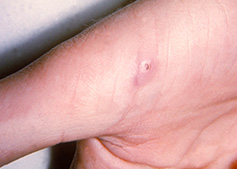How infectious diseases are spread and simple and practical advice for preventing the spread of infection in the home and community
Cat-scratch disease - including symptoms, treatment and prevention
Cat-scratch disease is a bacterial disease caused by Bartonella henselae.
How Cat-scratch disease is spread
Most people with cat-scratch disease have a history of bites, scratches or other contact with cats, especially cats less than 1 year old. The cats almost always appear healthy. The disease is more common in children than adults, probably because children tend to have closer contact with cats and kittens.
Signs and symptoms of cat-scratch disease
The infection is usually benign and self-limited – that is, most people will not become very ill and will get over the infection without any specific treatment.
 The first sign of cat-scratch disease is a small lump or pustule (pimple) (see image) at the site of a cat scratch or bite, developing within a few days, though often it is so minor that it is forgotten.
The first sign of cat-scratch disease is a small lump or pustule (pimple) (see image) at the site of a cat scratch or bite, developing within a few days, though often it is so minor that it is forgotten.
After another 1 to 7 weeks, swelling of lymph glands in the region of the scratch will occur. For example, if the scratch is on the arm, glands in the armpit on the same side of the body will swell. The lymph glands are usually painful, and may be as large as 6 cm in diameter. A mild fever is not uncommon and, very rarely, other symptoms may occur.
The infection may be more serious in people who have problems with their immune system.
Diagnosis of cat-scratch disease
Diagnosis is made on history and clinical symptoms as well as by blood test. Sometimes the doctor will take a sample of a swollen lymph gland. Testing of the removed lymph gland sample may confirm cat-scratch disease.
It is important to rule out other causes of swollen lymph glands, so if you have any, see your doctor.
Incubation period
(time between becoming infected and developing symptoms)
Usually 3 to 10 days for the first symptoms (the lump at the site of the scratch or bite), and another 1 to 7 weeks until the lymph gland swelling occurs.
Infectious period
(time during which an infected person can infect others)
Person-to-person spread does not occur.
Treatment for cat-scratch disease
Cat-scratch disease is a mild disease that tends to get better by itself over several months. Specific antibiotic treatment is usually not necessary.
Prevention of cat-scratch disease
- Exclusion from childcare, preschool, school or work is not necessary
- avoid cat bites and scratches - do not ‘play rough’ with cats or kittens
- wash cat bites and scratches immediately with soap and running water
- do not allow cats to lick any open wounds
- cover any open wounds with a dressing
- control fleas in your pets – even though cat-scratch disease doesn’t seem to be passed to humans by flea bites, there is evidence that it is spread between cats by fleas.
Useful links
Image - Lesion of cat-scratch disease, skin of thumb. Image courtesy Centers for Disease Control/Emory University; Dr. Sellers; Public Health Image Library (PHIL), Department of Health and Human Services, Centers for Disease Control and Prevention (CDC-USA)